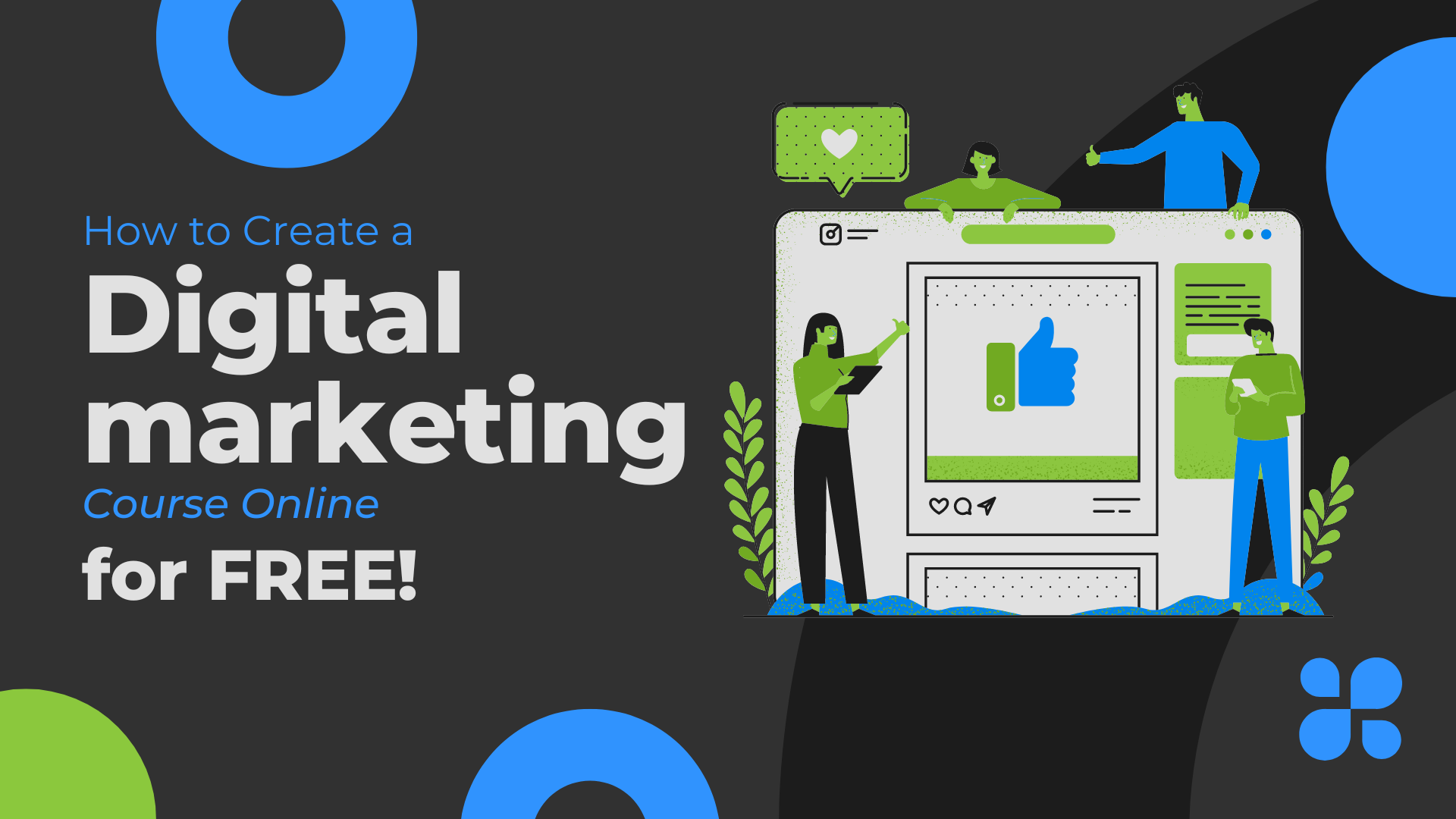How to Create a Digital Marketing Course Online

Introduction
Creating a digital marketing course online can be challenging. I've created many of them and know what works best.
Here are some secrets that you probably don't know:
Start with the basics.
The first step to creating a course is to start with the basics. Creating an online digital marketing course that teaches people how to market their business, product or service (or, simply how to do something) can be complicated, but it doesn't have to be. If you want your course to be successful, however, you need to make sure that it's easy for students and customers alike.
The best way for doing this is by using one of the many free templates available on sites like Udemy or Skillshare (if you don't already have your own). You can also use any number of tools such as:
A free image editing software (like GIMP)
A free audio editing software (such as Audacity)
A free video editing software (such as Windows Movie Maker)
One thing I would recommend against doing yourself is timing your lessons or adding audio effects using something like Adobe Premier Pro because there are so many resources out there which will do this for you at no cost whatsoever!
Compose an Outline.
Make a list of topics
Order them in a logical sequence
Use a mind map to see how they work together
Make sure there is a logical flow from topic to topic (i.e., don't put the first chapter in front of the last)
Make sure the topics are relevant to your audience's needs and interests (i.e., don't make your course about some esoteric subject that only occurs once per year on February 29th at 5:00 PM EST)
Write Content Notes.
If you're going to be creating your own digital marketing courses, you'll want to write content notes.
Content notes are essentially summaries of the content in each slide in your course. When writing them out, make sure that you keep the formatting consistent with what is already on the slides so that they aren't confusing when students read them.
If you're creating an online course, then it's very likely that there will be multiple sections or lessons in your course. Make sure to write content notes for each section or lesson as well! You don't want students getting confused and not understanding what they should know at this point in the course.
If there are modules within a lesson (such as learning how to install WordPress), then make sure those get documented too! This will help people stay organized and understand exactly where they left off before moving onto another module within a lesson or section of their learning experience with your coursework materials being distributed online.
Related: Blogging Skills To Learn that Every Blogger Needs to Know
Create Powerpoint Slides.
The first thing you'll want to do is create a consistent and clean layout. Pick the font that you think will be best for you, then use that same font throughout your slides. Also, pick out a color scheme and stick with it! It's important to have consistency in all of your slides so that it doesn't look like an amateur presentation. Remember: if you don't have any experience designing presentations or slideshows, don't worry! You can just copy a design from somewhere else or use PowerPoint's template options as inspiration.
Don't flip through Powerpoint slides.
Don't flip through Powerpoint slides. Your course is not just a collection of slides and bullet points. It's an experience that you want your students to enjoy, so don't break the flow by flipping through slides with one hand while you type on the keyboard with the other. Instead, take time to create an engaging presentation that will keep learners hooked from start to finish!
Don't use a standard template or design that's been used before—or at least don't do this without creating some unique content yourself first! You can find templates online if you need help getting started in terms of how layout should be organized visually, but try not to simply copy-and-paste entire sections into your course if they aren't completely original creations (which also means staying away from using any copyrighted materials).
Show and tell using screen capture software.
If you want to show and tell using screen capture software, there are a number of options.
We've used Jing in the past on our blog, but Camtasia Studio is also an option. With Camtasia Studio, you can record your screen as well as record audio while explaining things on the fly. It's also easy to make annotations or highlight certain parts of your screen that might be relevant for viewers.
Snagit is another popular solution for recording screenshots and videos from a computer's camera or from its entire desktop. This tool allows users to annotate their images with text, arrows, shapes and more before saving them into a variety of formats like PDFs and JPEGs so they can easily share them online with others who may not have Snagit installed on their computers yet themselves!
Screencast-o-matic offers similar features but includes some unique ones such as being able to record audio only instead of both video+audio simultaneously (for example if someone else was talking about something unrelated). If all else fails; try Screenflow which has many great options including adding text boxes onto screenshots which makes it easier than ever before making it simple enough even if someone doesn't know how too much HTML coding works yet!
Make it interesting.
Use a conversational tone.
Include some humor.
Use voiceover, for example: “On this page I’m going to show you how to create your own digital marketing course online for under $50…” This will help with engagement and also give you an opportunity to summarize some of the most important points that you want people to remember at the end of each section.
You can use a whiteboard or screen capture tool like Camtasia if you have them available or just film yourself talking directly into the camera (you might want someone else in your room as well, so they can take notes). If not, then use any video-based medium that works best for what you're trying to teach – it could be as basic as just talking straight into your webcam!
You can also try using images such as charts and graphs if appropriate; however, make sure these don't distract from what's being said in any way and keep them simple enough so that viewers won't have trouble understanding them quickly on first glance!
Stories are great ways of explaining concepts because they put real-world scenarios into perspective which makes learning more memorable than simply reading text off a page without context.
Build a sense of community.
You can engage with your audience and build a sense of community by using a chat room. A chat room is an online platform where students can ask questions and get answers from you or other students. You can also use the chat rooms to communicate directly with the people who want to learn from you—and with each other!
If you want to make money with your course, it's important that people feel like they're part of something bigger than just their own learning experience. That's why it's helpful to have forums where students can share resources and tips for each other, too!
A great example is Udemy itself: they have forums where people are helping each other out all the time! By posting in this forum myself, I've found out how much people love my courses (which makes me feel really good).
Make them practice what they've learned.
Once you've taught them the basics through your digital marketing course, make them practice what they've learned. Here are some ways to do this:
Use a quiz or test. This can be as simple as creating a Google form that asks students questions related to the topic and giving them a score based on their answers.
Use hands-on exercises that require students to use what they've learned in real life situations (this is good for beginners who need it spelled out for them). For example, if you're teaching SEO (search engine optimization), create an exercise where students come up with 10 keywords they want their website or product/service page optimized for and then write some content around those keywords; or if you're teaching PPC (pay per click) advertising, have students create ad campaigns using specific keywords that link back to their website or product/service page; etc…
Give examples from real businesses who have done this well (and not so well). If you work for an agency like I do at my job at Handsoap Inc., then use our own case studies as examples! It provides context for what we're talking about and helps keep things interesting by showing how other people have approached similar problems before us—which may also give your students ideas on solving theirs' issues too!
Show your personality.
Showing your personality is crucial.
Being a digital marketing teacher can be pretty dry and technical, but if you’re not yourself, it will show. You don’t have to be the life of the party or anything—just be honest and genuine with your students. Don’t shy away from being vulnerable; people appreciate when others are open about their struggles as well as their triumphs. If you don’t know something, say so! Your students will respect your honesty more than any false bravado could ever earn them in return.
Be relatable and authentic while still maintaining an air of mystery so that they want to learn more about who you are (and why). People are drawn to those who share similar interests or tastes—but no one likes someone who puts on airs or tries too hard (unless it's for comedy). You also want people to feel like there's some level of familiarity between them even though they haven't met yet--that way if someone needs help later down the road then they feel confident enough asking someone else rather than feeling insecure about asking themselves first (like most people do).
Export your Digital Marketing Course as an HD Video.
If you're using a free video editing software, the process of exporting your video is pretty straightforward. You'll export it as an HD file in the format of your choice (MP4 or AVI) and then upload it to either YouTube or Vimeo for hosting. If you're not using a free video editing software, like iMovie, Windows Movie Maker or Sony Vegas Pro 14 then this part will be slightly more complicated because you'll need to get some help from someone experienced with exporting videos from those programs.
Here are some things to keep in mind when exporting a video from iMovie:
Export as an HD Video: This option will give you the best quality possible for both YouTube and Vimeo
H264 Encoder Settings: Choose Baseline Profile at Level 3.0 (Advanced) for better compression efficiency and higher quality output
Audio Format: Select AAC as your audio format so that people can listen to your voice over narration clearly
Post to your website, social media or subscription blog.
Take your video link/code and post to your website, social media or subscription blog. Posting on your own website is always going to be the best option. This way, you will have complete control over the content and you can also choose what format it’s in – video, audio or text.
If you don’t have an audience for your course yet then posting on social media might be a good idea but make sure that there aren’t too many other courses about your chosen topic before you start posting yours! If there are too many courses with similar topics then people may not bother looking at yours because they think they already know everything about this topic already.
You could also try a free blog like Blogger or WordPress but just remember that if someone wants access to all of the videos in their course then they will need an account on one of these platforms such as YouTube so don't rely solely on this method unless you want all of your students signing up for multiple accounts just for one course!
Learn the secrets of making a great course out of nothing at all.
If you want to create a digital marketing course online that your students will find interesting, practical, and fun then here are some more tips:
Make sure it is relevant. Your content should be relevant to the problems that your target audience is facing. You can do this by researching what they're looking for and providing answers in your course material.
Make sure it's practical. If you're teaching something new then make sure the students can find use cases for what they've learned from your course as soon as possible after completing it (if this isn't possible then consider whether or not this topic deserves its own separate course).
Make sure it's interactive. The more interactive classes are typically better than those where students just sit back and listen because they're more fun too! However if there's no way around having passive learning styles within certain parts of each lesson plan then try adding videos instead of written instructions - both types have advantages & disadvantages but will ultimately help keep learners engaged throughout every session regardless how much time passes between one class ending & another beginning again later on down the road when someone else takes over teaching duties from yours truly.
Conclusion
Don't be afraid to jump in and start creating your digital marketing course online! The hardest part is over. You've defined your niche, gathered resources, written content notes and outlined topics for each lesson. All that's left is to put it together into a course outline with slides that flow from one idea to another in a logical sequence.
Remembering these tips will help you create an engaging learning experience for your students!


